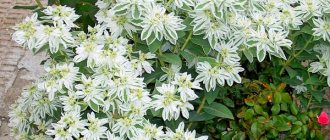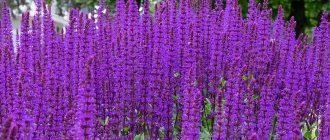Home » Flowers and plants
Vladimir 03/25/2020
138841 Views 1 comment
Roses
The process of growing roses in your garden involves following the basic rules of agricultural technology. This is a fairly spectacular and hardy plant that allows you to decorate hedges, flower beds, flower beds, and borders. Rose bushes are actively used in landscape design. Due to the variety of shapes, colors, and aromatic fragrance, this flower is one of the most popular in the garden.
Shrub roses: description
Blooming bouquet
There are different types of roses that differ in shape and height. Some varieties form a small bush in the form of a pyramid, others delight gardeners with their spreading shape.
The bush produces uterine (main) and annual shoots, which abundantly cover unpaired oval-shaped leaves with finely cut edges. The length of the flowering stem can reach 85 cm; flowers with a diameter of 3 to 20 cm grow on it in a wide variety of shapes and shades. One bud can have 5-120 petals, they can be in the form of inflorescences or grow as a separate flower.
Regarding the shape of rose buds, they are pompom-shaped, peony-shaped, cup-shaped, spherical, cone-shaped and flat.
Considering the annual cross-pollination of flowers, you can find the most incredibly beautiful colors of roses
Before you create a rose garden on your site, you need to become more familiar with the features of growing this amazing plant.
Agricultural technology for growing roses
Variety of species
Among the variety of forms for a rosary, multi-flowered, hybrid tea and climbing plant forms are chosen. Experienced gardeners can find dwarf, ground cover and erect tall varieties of roses.
In order to enjoy the flowering of this “queen” in your garden for as long as possible, it is recommended to know all its strengths and weaknesses:
- Hybrid forms are distinguished by a high degree of frost resistance, but it is better to cover young plants for the winter.
- In order for rose bushes to grow and develop well, it is necessary to carry out pruning, shaping, and sanitary pruning every year. Autumn pruning of secondary flowering plants is mandatory.
- Planting a crop is equally presentable, both as an independent plant and in group plantings. Roses look especially beautiful when decorating hedges and alpine slides.
- Not only proper planting and choice of variety ensure long-term flowering of the bush, it is also necessary to properly care for it.
Tips for designing a rose garden
To create a beautiful garden, two types of design are used:
- landscape (does not require strict rules, plants are placed in large groups);
- regular (the flower bed is made in the form of a geometric figure with an elegant stone edging).
When creating a design, it is recommended to adhere to several rules on how to beautifully plant roses in the front garden:
- To get a bright picture, it is better to use red or yellow roses.
- If the base of the flower garden is formed by plants of delicate light colors, then pink, lilac, and white roses are suitable for planting around the base specimens.
- To create a rose garden, you can use other crops, for example, lavender, irises, which will effectively highlight the beauty of the bushes.
- Before you start designing a rose garden, you should sketch out a rough plan on paper.
What is a rose? This is an amazingly beautiful, but quite whimsical plant. However, despite the demanding nature of the plant, caring for and growing this crop in the garden is not such a difficult task. To grow a beautiful and healthy shrub, you need to follow the basic rules of agricultural technology and adhere to general recommendations.
What growing conditions do roses need?
Moderate heat and sufficient illumination of the site have a beneficial effect on the growth and development of this crop.
When rose bushes are exposed to direct sunlight, the flower quickly withers and there is a risk of burns and scorching of its leaves.
To grow a rose garden, it is recommended to choose a well-lit area where the sun does not actively influence it at midday.
In addition, special attention should be paid to the location of groundwater. They should not be very close to the surface of the earth, at least two meters from it. If there is no other option, then in such places it is necessary to use high-quality drainage or use high ridges.
Drainage for the bush
Northern and north-eastern wind blowers cause many problems for plants, so it is recommended to take this factor into account when choosing a site. It is better to consider the area where southern winds dominate.
The most optimal soil for growing roses is loamy soil, well fertilized with rotted mullein.
Rules for choosing planting material - seedlings
First of all, when purchasing rose seedlings, you need to inspect their stem. It should be sufficiently ripe; when pressing on the side of the thorn, it is easily separated from the trunk. If this thorn does not break off, but only bends, then this planting material is unlikely to take root.
Distinctive features of a high-quality shoot: juicy, living bark, yellowish-whitish color of the roots.
Selection of seedlings
Determining the plant variety by the appearance of the planting material - seedling:
- The wrinkled variety is distinguished by the presence of multiple spines of different sizes.
- The loose rose has fairly large thorns that are located at a great distance from each other.
- The white rose variety is distinguished by the presence of strong pink crescent-shaped thorns.
- The Floribunda variety forms very strong paired thorns that are curved downwards.
Annual and biennial plants take root better. If the planting material has a wrinkled trunk and a dry root system, then it is not worth purchasing.
When and how to plant roses
It is advisable to purchase seedlings in September - October. In spring, there is a risk of buying last year's planting material.
To protect new plantings from diseases, it is not recommended to plant them in the place of previous roses.
Technology for planting rose bushes:
- Using a sharpened and treated garden tool, shorten the roots of the seedling and remove the dry parts. Cut the stem to a height of 16-20 cm.
Place the seedling in water before planting time
Dig a planting hole measuring 50x50 cm and 10 cm deeper than the size of the roots along with a ball of earth
Loosen the soil at the bottom of the hole
- Mix the excavated soil with compost at a ratio of 3:1. Add wood ash.
- Pour one bucket of heteroauxin solution into each well. Dilute the drug according to the instructions.
Place the seedling in the hole and cover it with fertilized soil, holding it. The main thing is that all the roots are straightened
Make a ditch around the trunk for irrigation
- Hill up the planted seedling by at least 15 cm and shade it for 10-12 days.
Make the next watering two days after planting.
The optimal distance between rose varieties is 1-2 m.
Varieties
There are many varieties of roses, and their list is constantly growing. According to statistical studies, every year the number of varieties increases by 200. Park and garden roses are used for landscaping for decorative purposes.
They do not require shelter and can withstand the winter season with minimal protection. For example, spiny or bluish varieties. Frost-resistant roses include Damask, white, and French varieties.
Garden roses are bred through selective breeding. In order to grow such flowers, agricultural technology is used. These are delicate flowers that require protection in the cold season. Their number at this time is about 20,000. Moss, Cordes, miniature, semi-climbing varieties are among the most popular types.
How to plant roses in autumn and spring
If planting is planned in the fall, then it is necessary to begin preparations for this planting event 2-3 months in advance, namely:
- Dig a hole, lay a drainage layer on the bottom in the form of broken bricks, medium crushed stone, expanded clay. This technique will protect the roots of the bushes from rotting.
- Prepare the soil: dig it up, add organic fertilizer, humus, rotted leaves at the rate of one bucket per 1 sq.m., 2 tbsp., bone meal and 2 tbsp. wood ash, 40-60 g of superphosphate.
- If the soil is excessively clayey, then it must be diluted with sand at the rate of one bucket per 1 square meter. m.
Bushes planted for the winter must be sprinkled with earth or sawdust; you can use pine needles
In spring, plants are best planted between April and May. For this:
- Prepare the soil as you would for autumn planting.
- Trim the elongated roots and remove the damaged parts. The stem is shortened to a height of 10-15 cm, the number of buds should not exceed 3-4 pieces.
- Keep the seedling with dried roots in a container with water for 24 hours and treat them with clay and manure mash before planting.
- Drawing of a seedling being kept in water
- Pour soil into the planting hole in the form of a hill and place the seedling in the center. Gently sprinkle the roots with soil, lightly tamping it down.
- Water the bush generously and hill it up.
- As soon as the first shoots appear, level the earthen mound and mulch the ground around the bush with sawdust or pine bark. The mulch layer should be at least 6-7 cm.
Shelter for the winter
This point is worth considering in a little more detail. The safety of plants depends on the quality of the shelter, but it is equally important to remove it in time and carry out a number of measures that are relevant at this time.
Peonies planting and care in open ground at the dacha
Roses are heat-loving plants. They are prepared in advance for overwintering, namely:
- create conditions for shoots to ripen;
- stop fertilizing with nitrogen in the second half of summer;
- reduce the frequency of watering.
In this way, the plants gradually move into a calmer phase and prepare for winter. In October, before covering, unripe shoots and flowers should be cut off, then before frost sets in, the bushes should be hilled to a height of 10-12 cm.
With the onset of stable frosts, climbing roses are removed from their supports and laid on the ground, and standard roses are bent to the ground and pinned. Leaves, spruce branches, and peat can be used as shelter. For additional insulation, a structure is constructed from non-woven material.
Attention! A layer of dry grass or leaves should be placed on the ground under the lashes to prevent contact with wet ground. This will prevent the shoots from rotting when the snow melts in the spring.
Roses should be provided with shelter for the winter.
In early spring, as soon as the snow melts, the plants are freed from shelter. You should not open the roses completely right away - a sudden opening can harm them. As it warms up, it is necessary to gradually remove the insulation, layer by layer. After the plantings are completely cleared, pruning is carried out, during which all damaged and diseased shoots are removed.
How to care for rose bushes in your garden
The formation of this amazing culture is carried out throughout the year, where the main task is to pinch the tips of vegetative organs - shoots. This technique allows you to increase the growth rate of bushes. To prevent flowering from weakening the young plant, it is necessary to remove the emerging buds at the beginning of summer.
Rose bushes are very demanding plants for moisture and its deficiency can cause the growth of young shoots to stop, as well as the plant to wither and its leaves to fall off. Ultimately, the culture loses its decorative value.
Water treatments
Abundant watering of the bushes is especially necessary at the stage of its growth and formation of buds and leaves, after the first flowering. It is best to use melt or rain water. Watering must be done in a pre-prepared ditch.
Up to 15 liters of water are used per plant, applying it several times. The optimal number of procedures is once every 7 days, and on dry days the interval between waterings is increased to four times.
Watering roses in autumn
It is not recommended to water the bushes abundantly in August - September , as this can damage the plantings. With an excess amount of moisture, the bush continues to develop, in which the young shoots do not have time to fully ripen. To prevent them from dying when the first frost occurs, artificial irrigation should be completed at the end of the season.
If autumn turns out to be hot, then you can irrigate the bushes moderately, using up to 12 liters of water per plant. This supply of moisture will be quite enough to wait out the winter period.
Features of fertilizing
Mulching the soil must be done before the buds open. Mulch is prepared from humus, peat or mature compost. It is poured at least 10 cm.
As a result, the soil is saturated with useful microelements, which contribute to the active growth and development of the plant.
Nutrients are added in the first year, the frequency of procedures is three times a year. Moreover, for each time of year a certain type of fertilizer should be used.
Plant nutrition
It is especially effective to introduce both mineral elements and organic matter at the same time. In terms of duration, organic compounds work more slowly, but provide better soil quality.
If the soil is clayey, then fertilizer is applied less frequently, and if it is sandy, then more often.
It is recommended to use dry fertilizers after rains or artificial irrigation. It is necessary to scatter the fertilizer around the plant, retreating 15 cm from the trunk. Be sure to water the bush after feeding.
There is no need to fertilize during the period of active color.
How and when to prune rose bushes
In spring, the plant begins to awaken after winter and grow intensively, laying buds, strengthening the flowering stem and releasing new shoots. If dormant (underdeveloped) processes are found, they must be removed. Dormant shoots should be trimmed to 1-2 leaves.
After pruning, the plant must be fed with a liquid organic or mineral composition.
Bush pruning
After some time, the bush forms new powerful shoots. If weak shoots appear in autumn, they should not be pruned, as this can weaken the bush.
Reproduction of the Queen of the Garden
There are not many ways to propagate roses. But the desire to have as many of these undeniably beautiful and diverse plants on the site as possible is so great that gardeners strive to master them all to the maximum extent. Here is a list of ways to propagate roses:
- Budding. A T-shaped cut is made on the bark of the plant trunk close to the ground level, into which a bud of a cultivated variety is inserted, after which it is secured with film. The scion can use the developed root system of the rootstock. This operation is simple, but requires some experience.
- Seeds. This method is used extremely rarely due to the fact that you have to wait a long time for the result, and there is no confidence that it will be positive. And the germination of rose seeds leaves much to be desired.
- Layerings. Shrub and climbing roses are propagated this way because they have long and strong stems. The shoot of the plant in the lower part is cut for 8 cm, and a sliver or match is inserted into the cut. The cut part of the shoot is placed in the ground and fixed, and its free tip is tied to a peg. The rooted shoot is cut off from the parent bush.
- Cuttings. The good thing about this method is that roses rooted this way will not produce wild shoots. The cutting is part of a strong shoot. It is cut off next to the leaf bud and germinated using root formation stimulants. After the root appears, the rose can be planted in the ground.
The layering method is good to use only for propagating plants with long stems, which are used to create a new rose bush
What diseases and pests can damage rose bushes?
Despite the plant’s sufficient tolerance to various negative environmental factors, it can be attacked by various garden pests and pathogens, for example, fungi and bacteria. They must be controlled using appropriate fungicides.
Bush processing
A soap-oil emulsion made from washing powder, diesel fuel or machine oil in the amount of 5-6 tablespoons of each ingredient per liter of hot water has proven itself well. The resulting mixture must be diluted in ten liters of cold water and the bushes must be treated in the evening, provided there is no wind.
An effective folk remedy against aphids, mites and thrips is a tincture based on garlic or onion.
Powdery mildew is considered the most common disease of rose bushes. To combat it, use a solution of water, laundry soap and soda ash. For preventive purposes, in the fall, all collected dry leaves must be removed and burned.
Among the most common diseases and pests of roses are:
- aphids
- powdery mildew
- red spider mite
- leaf bee
- caterpillars, snails, slugs
- bacterial cancer
- gray rot
- leaf spot
- diseases of viral origin
- foam bib











